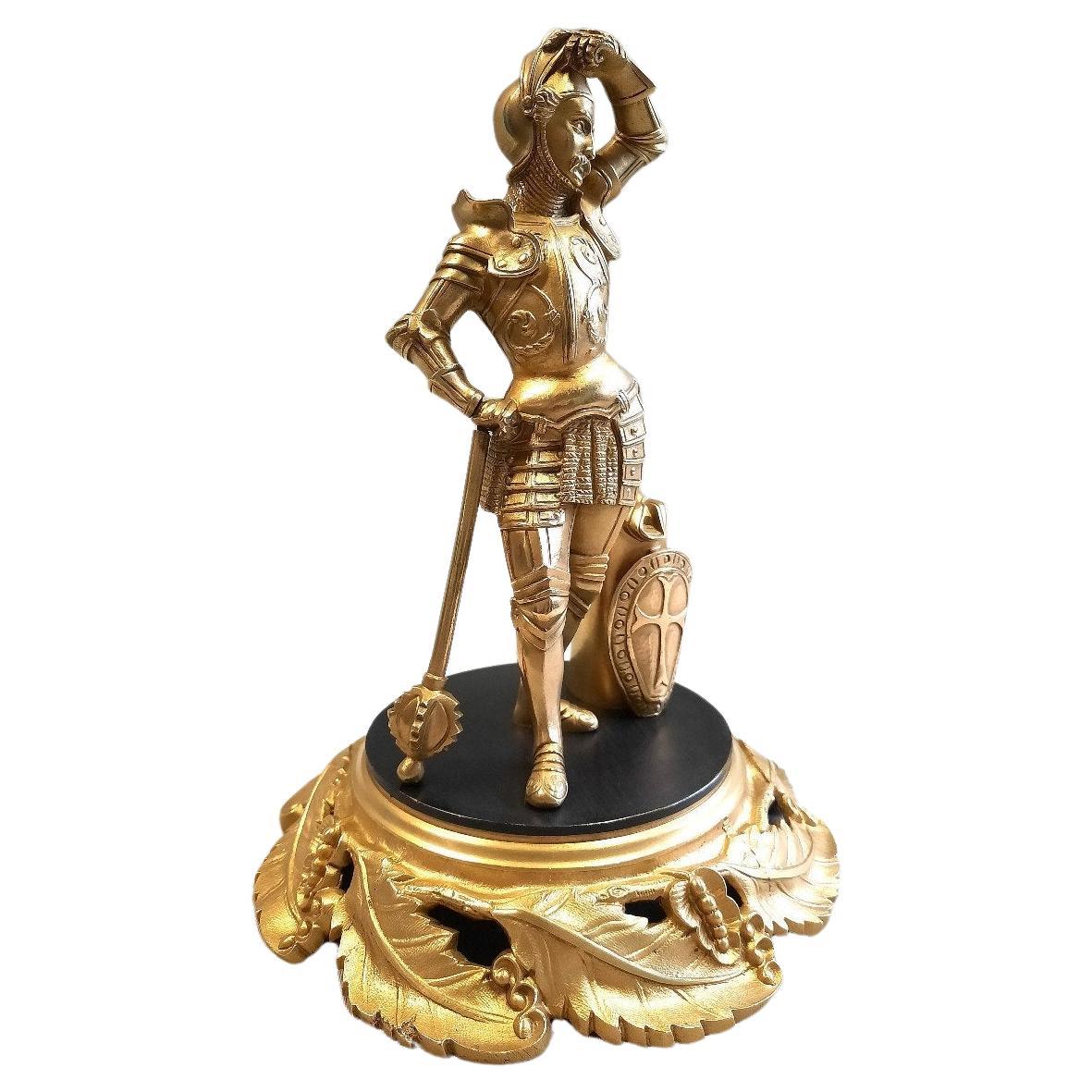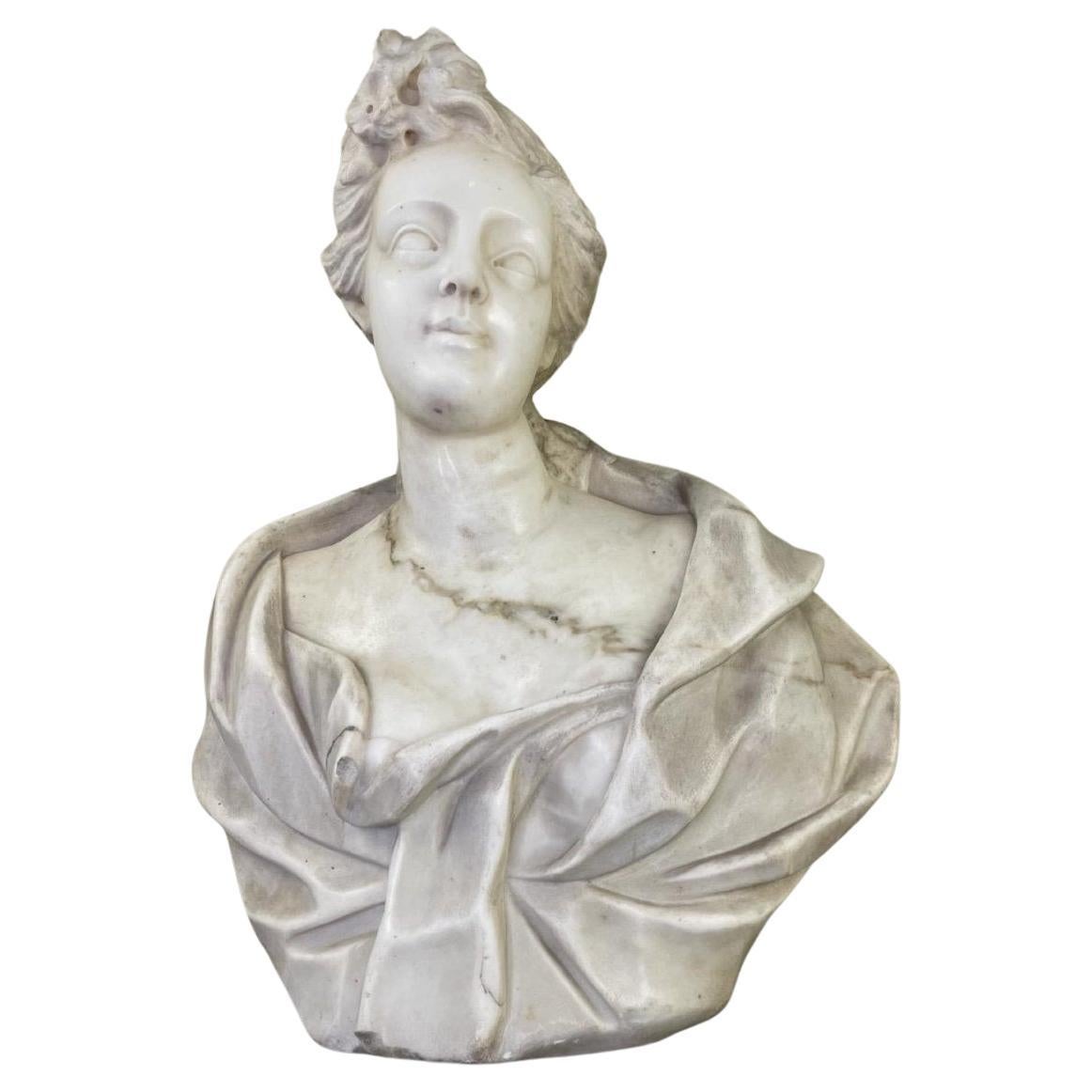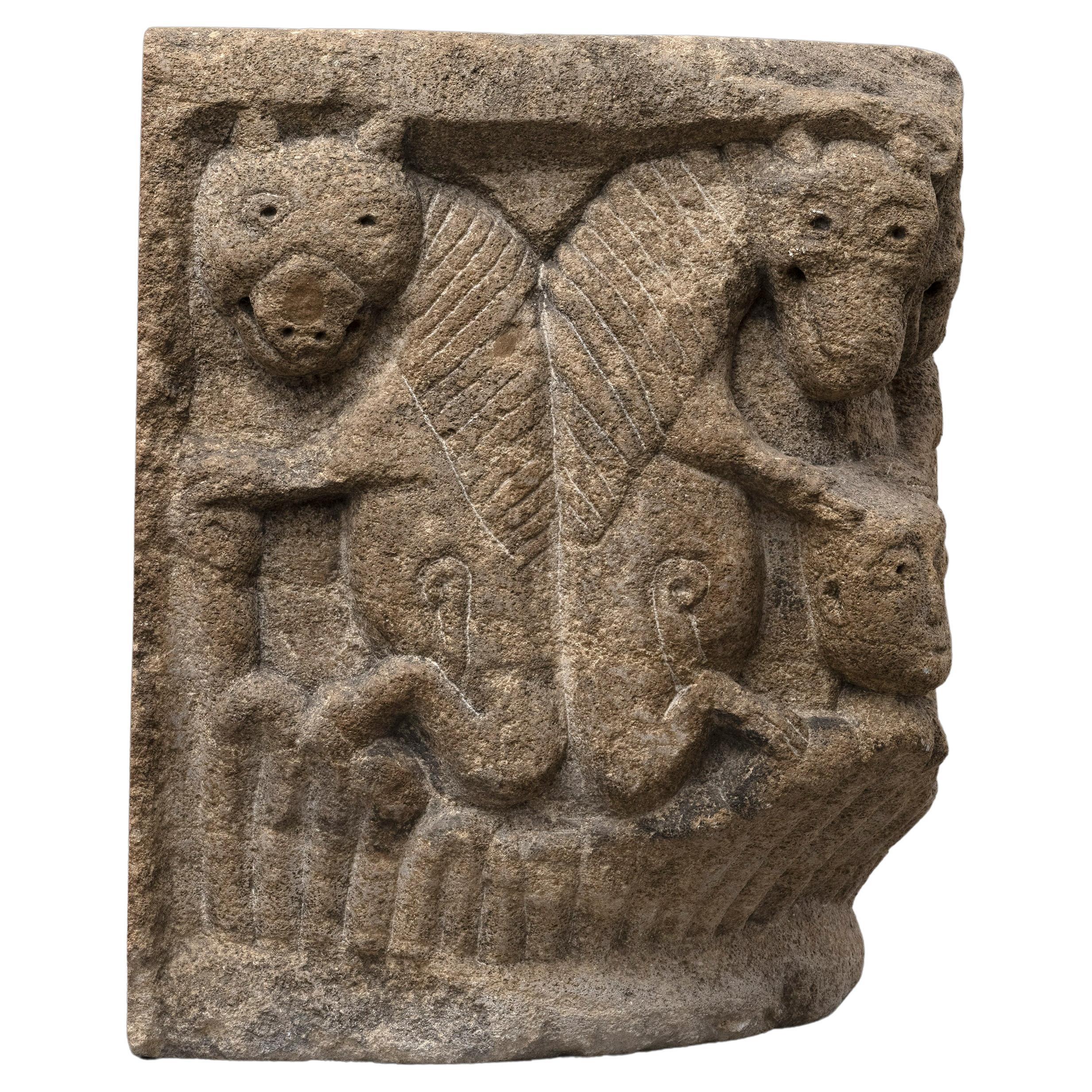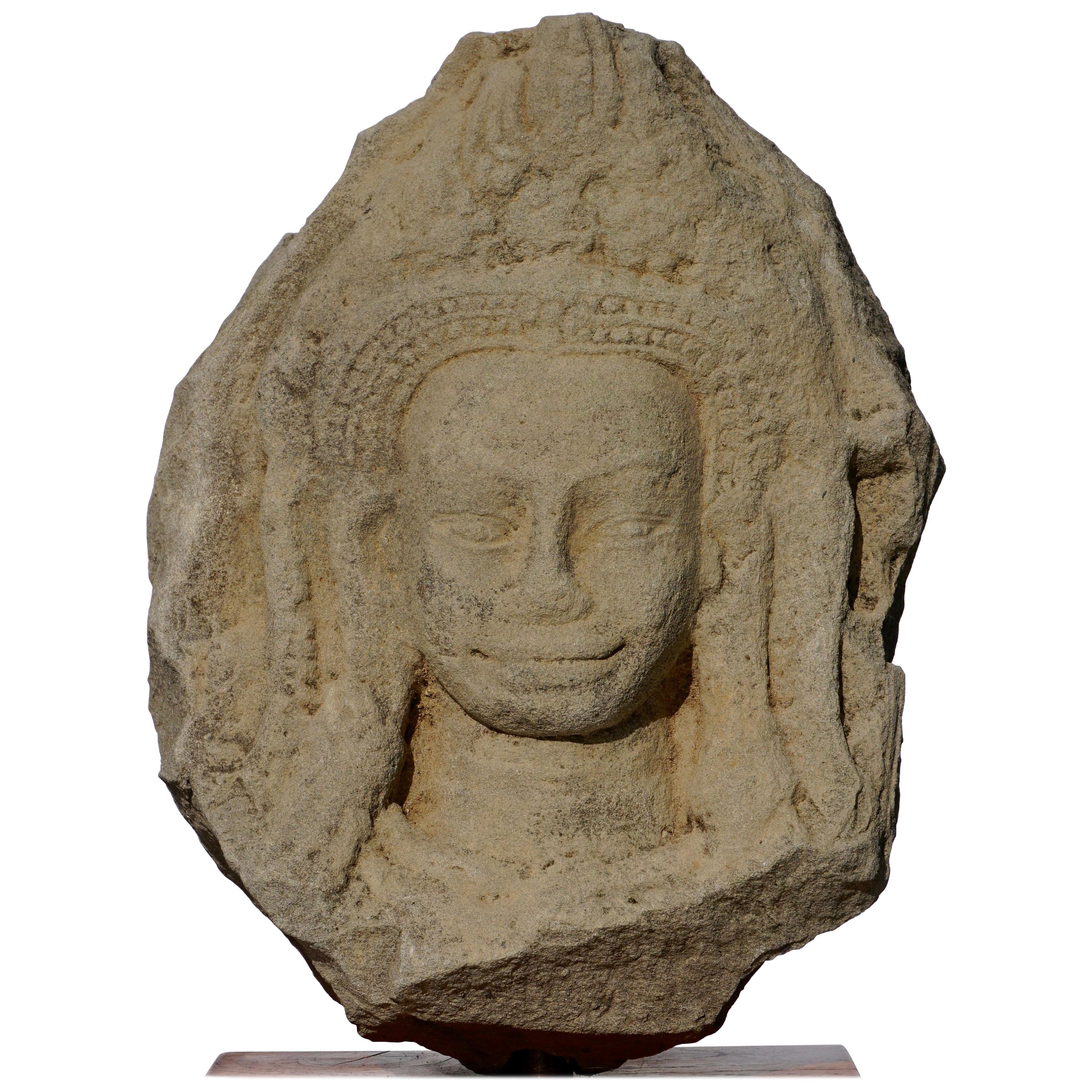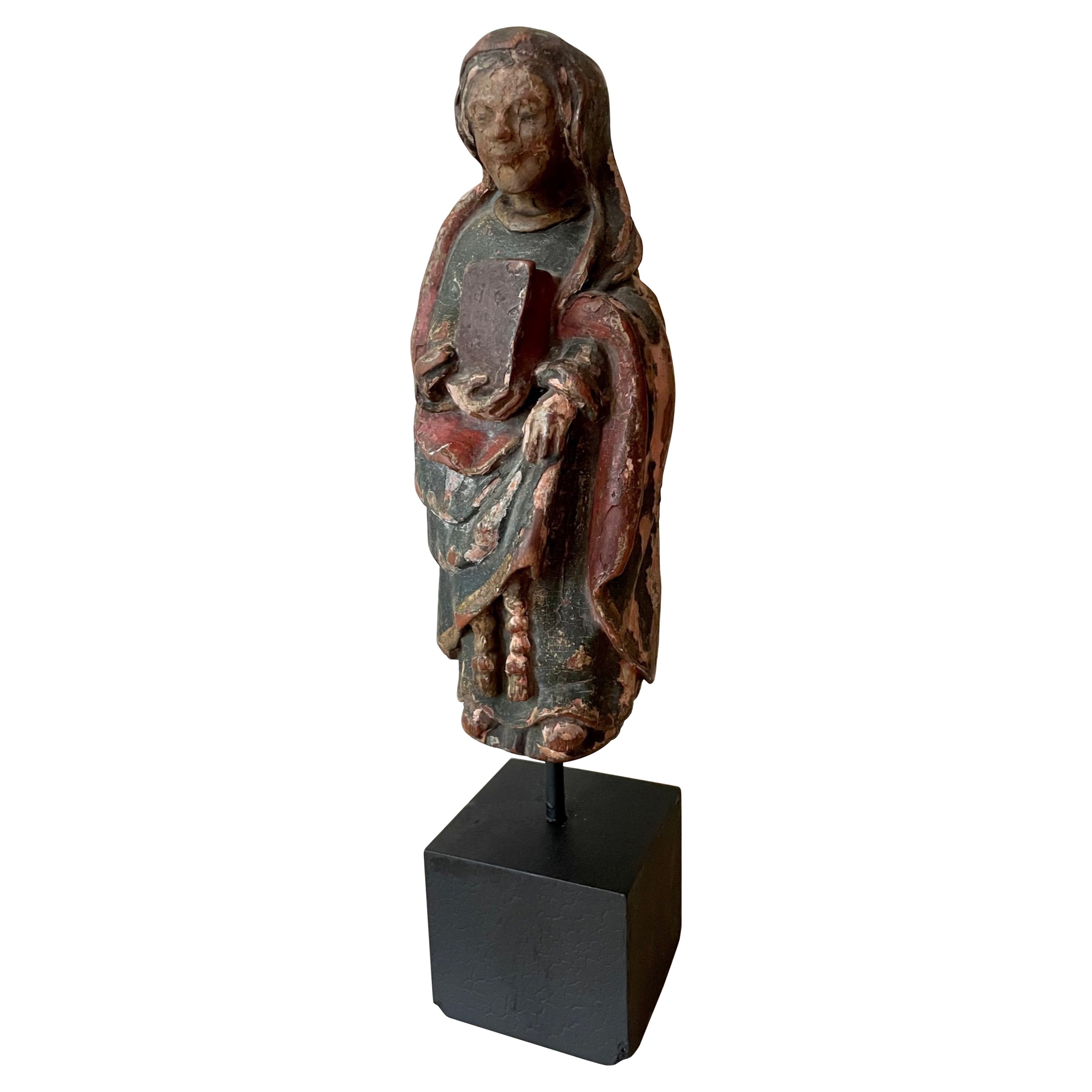Items Similar to Telamon - Northern Italy, late 12th (Reemployed Roman marble)25000
Want more images or videos?
Request additional images or videos from the seller
1 of 8
Telamon - Northern Italy, late 12th (Reemployed Roman marble)25000
About the Item
Telamon
Northern Italy, late 12th - early 13th century
Reemployed Roman marble
H 32 x L 18 x P 17 cm
« Sono coloro che hanno dimenticato che l’uomo é solo un bruco, destinato a diventare farfalla solo nell’aldilà : ora sono curvi come telamoni sotto pesi troppo grandi rispetto alle loro forze, tanto che quello che sembrava poter sopportare di piu il suo carico piangendo parea dicer : Piu non posso.
« Dante, Divina Commedia, I superbi, Purgatory ».
Sitting, crushed under the weight it supports, witnessing eternal punishment, the telamon was an iconic image in the Middle Ages.
I can no more ! Cried the penitents in the purgatory of Dante: the superb in the Divine Comedy are exhausted souls, responsible of their guilt, holding on their shoulders the weight of a heavy boulder as the arrogance perpetrated during a lifetime. The bodies are bent, collapsing on themselves according to an image that Dante compares to the prostrate figure of a telamon.
The title of “Gobbo”(hunchback), derive from his posture, kneeling and hunched under the weight of the marble slab that rests on his head to visualize the weight of the peaches of humanity. Emblematic image of Middle Ages, the hunchback becomes subject of sculpture used as support for columns, plinths and baptismal fonts pulpits and thrones.
This telamon, carved from a block of marble from the Roman period, reemployed as was common in the Middle Ages, bears on the reverse the inscription "SEX".
Is particularly evident the forced posture, with the head squeezed between his shoulders, up to protrude beyond the natural axis of his body.
He wears a tunic tight at the waist by a belt like the telamon kept at the Museo Civico de Piacenza (circa 1110-1130), at the Victoria and Albert Museum in London (1140-1150) and the pair of monumental telamon of the Louvre.
His clothes are typical of the civil fashion of the time: the sculpture witnesses a search for a figurative realism free from the purely symbolic and allegorical repertoire which characterized religious monuments of the time.
Telamon are an architectural innovation that spread in the north of Italy, especially in Emilia Romagna and Lombardy, from the first third of the 12th century and whose fortunes lasted for two centuries. The oldest sculptures representing telamons are those from the Duomo of Cremona dated between 1107 and 1117 (one of which is visible at Castello Sforzesco in Milan).
Often presented in pairs to support the columns of the facades, the gobbi are the sculptural development of an iconographic model which already appears in a series of illustrations visible in a codex from the beginning of the fifth century, "calendario di Filocalo" where a series of images representing the seven planets are inscribed inside a canopy placed on the shoulders of two telamons.
In the well known examples of Bologna, Cremona, Piacenza and Ferrara, the telamons always appear as a couple, a young and an old. This dualism is inspired by the symbolism of the solar circle where the two figures visualize the two parts of the year: the increasing sun and the decreasing sun.
The fortune of this iconographic model lasted until the 14th century when in 1367 Giovanni da Campione was commissioned to realize the facade of the Basilica of Santa Maria Maggiore in Bergamo, probably the last example of telamon produced testifying to the fortune of this iconographic model.
Hunchbacks were a major attraction for passing foreigners and their popularity was highlighted in 1910 by Alice Maude Allen in her book "History of Verona":« The two well known gobbi inside the church supporting holy water basins are masterpieces in their way ».
Bibliography:
A.M.ALLEN, A history of Verona, London 1910, p. 368
S. LOMARTIRE, Telamone, in Matilde di Canossa. Il Papato. L’Impero. Storia, arte, cultura alle origini del romanico, catalogo della mostra (Mantova, casa del Mantegna, 31 agosto-11 gennaio 2009) a cura di R.Salvarani, L. Castelfranchi , Silvana Editoriale, Cinisello Balsamo 2008, pp. 405-406, n. X. 27
E. NAPIONE, i Gobbi di Sant’Anastasia, Museo Civico di Verona, Septembre 2018
P. WILLIAMSON, Catalogue of Romanesque sculpture in the Victoria and Albert Museum, V&A Publications, London 1983, pp. 50-51, n. 22
- Dimensions:Height: 12.6 in (32 cm)Width: 7.09 in (18 cm)Depth: 6.7 in (17 cm)
- Style:Medieval (Of the Period)
- Materials and Techniques:
- Place of Origin:
- Period:
- Date of Manufacture:12th century
- Condition:Wear consistent with age and use.
- Seller Location:Bruxelles, BE
- Reference Number:1stDibs: LU6666239114232
About the Seller
5.0
Vetted Seller
These experienced sellers undergo a comprehensive evaluation by our team of in-house experts.
1stDibs seller since 2022
6 sales on 1stDibs
Typical response time: 5 hours
- ShippingRetrieving quote...Ships From: Bruxelles, Belgium
- Return PolicyA return for this item may be initiated within 3 days of delivery.
More From This SellerView All
- Rare Romanesque Capital Representing Daniel in the Lion’s Den, 12th CenturyLocated in Bruxelles, BEEngaged Romanesque capital representing Daniel in the Lion’s den France, 12th century Limestone 38 x 29 x 18 cm Provenance : Private coll...Category
Antique 15th Century and Earlier French Medieval Architectural Elements
MaterialsLimestone
- Marble Roman relief representing a ChristogramLocated in Bruxelles, BEMarble Roman relief representing a Christogram Roman relief - 4th century 25 x 22 x 8 cm Provenance : Collection of the Château de B. À Nevers by Georges C.S., scholar born in 1833 and deceased in 1909 The entire castle and its collections were acquired in 1938 by the current owners of the estate A christogram is a monogram or combination of letters that forms an abreviation for the name of Jesus Christ. This rare fragment combines chi (X) and rho (P), the first two letters of Christ's name in Greek and it is one of the oldest and most popular early christian symbol. The monogram of Christ, or chrismon, is also a powerful symbol of imperial victory: it appeared to Emperor Constantine the Great before his battle against Maxentius in ad 312, promising victory in the name of Christ. In Plato's Timaeus, it is explained that the two bands which form the "world soul" (anima mundi...Category
Antique 15th Century and Earlier Italian Classical Roman Figurative Scul...
MaterialsMarble
- Marble Lion, Périgord, 17th CenturyLocated in Bruxelles, BEMarble lion white marble France, probably Périgord, 17th century Small marble lion wearing a coat of arms pendant with the engraved date, ...Category
Antique 17th Century French Renaissance Animal Sculptures
MaterialsMarble
- Monumental Feminine Head - Roman Empire - 3rd-4th Century AdLocated in Bruxelles, BEVery large feminine head crowned by a tiara Roman period, 3rd - 4th century AD Eastern provinces of the Roman Empire (Palmira?) gray basalt H 55 cm Old collec...Category
Antique 15th Century and Earlier Syrian Greco Roman Figurative Sculptures
MaterialsStone
- Massacre of the Innocents, Normandy, Late 16th CenturyLocated in Bruxelles, BEThe Massacre of the Innocents Carved oak panel Normandy, late 16th century (Collection labels on the back) Measures: 43,5 x 61 cm.Category
Antique 16th Century French Renaissance Wall-mounted Sculptures
MaterialsOak
- Cerberus, Italy, 17th CenturyLocated in Bruxelles, BECerberus Black painted stone Italy, 17th century Measures: 80 x 69 x 36cm (one head missing) Cerberus, cruel monster, fierce and strange, Through his wide threefold throat barks as a dog Over the multitude immers'd beneath. His eyes glare crimson, black his unctuous beard, His belly large, and claw'd the hands, with which He tears the spirits, flays them, and their limbs Piecemeal disparts (Dante, Inferno, Canto VI). Cerberus figure seated, in his role of ferocious guardian of the underworld; he shows a nervous musculature, an adherent skin which reveals the ribs, long and robust limbs; his heads are broad and the eyes set well apart. Painted in black to amplify his menacing look, the infernal guardian is depicted with his famous attributes, writhing his heads, growling and barking furiously. Cerberus, in Greek mythology, was the monstrous watchdog of the underworld – also known as the “hound of Hades” – preventing the dead from leaving, and making sure that those who entered never left. A child of Typhon and Echidna, he was part of a monstrous family, which included Orthus, the Lernaean Hydra, and the Chimaera as well. Only on three occasions Cerberus was tricked by visitors of Hades: Heracles did it with his strength, Orpheus with his music. In "The Inferno", Dante places Cerberus as the guardian of the third circle of Hell. With his three mouths, Dante saw Cerberus as a beast that was synonymous with the sin of Gluttony. Virgil gets past the monster by throwing mud in his three mouths, temporarily choking him. Very rare are the representations of Cerberus in ancient statuary...Category
Antique 17th Century Italian Renaissance Figurative Sculptures
MaterialsStone
You May Also Like
- 12th Century Italian Roman Marble LionBy Europa AntiquesLocated in Madrid, ESItalian Romanesque 12th century marble recumbent lion 12th century Italian roman marble lion with a stylized mane and tail wrapped around its body a...Category
Antique 15th Century and Earlier Italian Gothic Animal Sculptures
MaterialsStone
- Bronze Sculpture 12th Century Soldier In Armor Late 19th CenturyLocated in CHALON-SUR-SAÔNE, FRChiseled bronze sculpture with gold and black patina. Crusades soldier in armor. The time of the Crusades is between the 1095-1291 centuries. the sculpture dates from the end of the ...Category
Antique Late 19th Century French Medieval Figurative Sculptures
MaterialsBronze
- Female Bust In Carrara Marble, Late 18th Century, Northern ItalyLocated in Honnelles, WHTFemale Bust In Carrara Marble, Late 18th Century, Northern ItalyCategory
Antique Late 18th Century Italian Louis XV Busts
MaterialsCarrara Marble
- 12th Century Khmer Sandstone Buddha Apsara HeadLocated in Dallas, TXA large Cambodian Angkor Wat attributed sandstone head of an Apsara with an ornate flame crown. Mounted on a wood base, 12th century. Measures: Height 11 x 9 inches With stand 13.3 ...Category
Antique 15th Century and Earlier Cambodian Agra Figurative Sculptures
MaterialsSandstone
- 12th Century Rare Romanesque Wood Sculpture of the Virgin MaryLocated in Vero Beach, FL12th century extremely rare romanesque wood sculpture of the Virgin Mary. Magnificent wood hand carved sculpture of the Virgin Mary holding a book to her chest. It is an extremely rare survivor of the 12th century. The style is European, possibly French or English. This statue is a testimony to beautiful religious art from about 1150. A truly rare Romanesque sculpture...Category
Antique 15th Century and Earlier English Medieval Figurative Sculptures
MaterialsStone
- 12th Century Indian Carved White Marble Figure of a Jain Tirthankara or JinaLocated in Austin, TXA well carved Indian white marble Jain temple relief fragment featuring an image of a Jina, circa 12th century, Rajasthan or Gujarat, India. The Tirthan...Category
Antique 15th Century and Earlier Indian Antiquities
MaterialsMarble

